Adrian Collins's Blog, page 128
August 11, 2022
REVIEW: The Garden of Empire by J.T. Greathouse
The Hand of the Sun King was the first-person autobiographical recounting of Wen Alder’s formative years. As The Garden of Empire mentions quite early on, there is still much of Wen Alder’s story to tell, yet this is now becoming the story of an empire. This is a neat way of explaining that throughout this entry, we follow Alder’s first-person perspective again, and we also follow another handful of point-of-view perspective characters, in the third person. Alder’s former tutor Kora Ha is one of the perspectives presented, as is Hand Pinion, brother to Alder’s one-time best friend. These are both characters that readers will be familiar with from the first book, and to bolster this tale of the empire is a new character who has an untamed magic and potential that is making the Gods pay attention, in a similar fashion to the way they are acknowledging Alder’s presence and importance. The switch between first and third-person perspectives works smoothly and isn’t jarring at all. It’s seamless to the extent I only really noticed it when I was 75% through the novel.
 The Hand of the Sun King was presented as Alder having to choose between two sets of cultures, magics, and loyalties. Playing in the back of his mind was his competitive drive and ambition to gain the full potential of unrestricted magic that he had glimpsed so briefly and dangerously in his youth. In The Garden of Empire Wen Alder (or Foolish Cur as he’s known to one contingent) has picked and/or been forced to choose a side. He still wishes to master and understand magic’s full potential and he wants to draw his own route through the world whilst keeping those he cares about safe.
The Hand of the Sun King was presented as Alder having to choose between two sets of cultures, magics, and loyalties. Playing in the back of his mind was his competitive drive and ambition to gain the full potential of unrestricted magic that he had glimpsed so briefly and dangerously in his youth. In The Garden of Empire Wen Alder (or Foolish Cur as he’s known to one contingent) has picked and/or been forced to choose a side. He still wishes to master and understand magic’s full potential and he wants to draw his own route through the world whilst keeping those he cares about safe.
I commented within my The Hand of the Sun King review that the magic system seemed tidy and not over-complicated. It’s more of the same here, however, the cannons of magic, the different styles of power, and the way that they can be wielded are all presented as more in-depth and expanded upon. It’s at a point now that with Greathouse’s set foundations, further explanations, and Alder’s magical trials and exploits, as a reader, we understand the magic as precisely as Alder does. This is with all its potential and possibilities, yet it isn’t without its dangers and unpredictability.
I really enjoyed following Alder as a protagonist again which I guess makes me a glutton for punishment as lots of unfortunate things still seem to happen to him and those he cares about. This is taking into consideration that he’s grown and matured, and all things considered, seems to be making better choices and giving pretty good advice. Alder has traits and “luck” that are reminiscent of FitzChivalry Farseer from The Realm of the Elderlings, one of my favourite fantasy protagonists.
Alder’s point of view page time was my favourite to follow but Koro Ha and Pinion’s chapters definitely grew on me the more I read them. With Koro Ha, with see the reverberations of him tutoring someone who, unbeknown to him, would become a rebel. Through his storyline, we witness new cultures and parts of the world that weren’t shown in the first entry. With Hand Pinion’s narrative, readers are presented with the internal happenings of the empire: the opposite side of the rebellion, maybe elements of imposter syndrome when he compares himself to his brother, and someone who wants revenge. There are also many side characters who shine when they are given the limelight. Many members of Greathouse’s ensemble are an absolute joy to read about, effortlessly complimenting the main players and showcasing excellent banter, wit, and dialogue. There are a few hidden motives, mysteries, and revelations throughout too.
I rated The Hand of the Sun King with a strong 9/10 rating. I’ll award The Garden of Empire with a 7.5/10 yet I think most who enjoyed the first will find a lot to savour here too. I personally thought that between the 35%-70% mark, some chapters dragged a bit and I wasn’t glued to the pages as I had been at other points in this series. Some of these slower moments were successful though in adding quality and depth to the world-building and Greathouse’s fantasy world feels a lot more complete and organic now.
Koro Ha’s tale and another point of view narrative don’t have as much of a solid and rewarding payoff as Alder and Pinion’s do. That being said, the loose ends with regards to those characters seem very intriguing and the last 20%, in general, is superb and on par with the finest moments I’ve read in SFF so far this year. The characters and the world at the end of The Garden of Empire are almost unrecognisable from what we’re welcomed to at the start and I’m all-in for the final novel in this series, which Greathouse is hopeful will be released in 2023. I can’t wait to see what happens next to Wen Alder/Foolish Cur and how his decisions will continue to affect the empire and the world.
I received a review copy of The Garden of Empire in exchange for an honest review. Thank you to J.T. Greathouse and Gollancz.
Read The Garden of Empire by J.T. GreathouseThe post REVIEW: The Garden of Empire by J.T. Greathouse appeared first on Grimdark Magazine.
August 10, 2022
An interview with Foz Meadows
Foz Meadows is Hugo award, Nora K. Hemming Award, and a Ditmar award for their essays, reviews, short fiction, and stories. They have appeared in everything from Uncanny Magazine to The Huffington Post. Foz will be releasing their queer fantasy novel A Strange and Stubborn Endurance in August.
It was an absolute treat to talk to them and find out a bit about what makes inspires them.
 [GdM] I read that you decided at age 12 to become a writer. How did that happen? What led you to that discovery?
[GdM] I read that you decided at age 12 to become a writer. How did that happen? What led you to that discovery?
[FM] It’s hard to remember my exact thought process, but I’d been writing stories for fun since I was six or seven, and at a certain point, I realized that was a job people had, which meant I could do it, too. I was one of those kids who was always reading, always writing, and while I went through periods of wanting to do other things – most notably archaeology and journalism – it was always as well as, not instead of. It probably helped that I grew up in a house full of books: my parents both wrote for a living, and they always encouraged me, so it never felt unachievable. But at the same time, I had no idea how the industry worked, which was its own learning curve once I got older!
[GdM] Which stories have had a considerable effect on you? I know you are a fan of The Goblin Emperor by Katherine Addison; who else do you love?
[FM] I’d be here for days if I tried to list everyone, but some of my favourite authors right now are Martha Wells, N.K. Jemisin, K.J. Charles, Aliette de Bodard, Kate Elliott, Yoon Ha Lee, Lois McMaster Bujold, June Hur and Django Wexler. At this point, there’s so much brilliant work being written in SFF that I feel like everything I read is affecting me, because I’m constantly in awe of the field. Tamsyn Muir’s use of language and voice in the Locked Tomb series, Shelley Parker-Chan’s incisively mirrored internalities in She Who Became The Sun, Silvia Moreno-Garcia’s nuance and versatility, Lee Mandelo’s sense of place and deep understanding of people – it’s all just breathtaking. I’ve been reading Mo Xiang Tong Xiu’s work as the installments come out in English – I did try the unofficial translations, but I struggle to read long works on my phone – and there’s these moments with her characterization where I want to bow down, it’s so good. Right now, I’m reading an ARC of The Archive Undying by Emma Mieko Candon and it’s just phenomenal: the prose, the pace, the concept. I’m spoiled for choice!
[GdM] You have a deep love of webcomics. Which one is your favorite, and why?
[FM] Oh man, webcomics! There’s a few I’ve been reading for literally twenty years now, which feels insane to say, because what even is linear time? Of the ones I follow currently, I don’t think I could pick a favourite, because they’re all too different; I really love Wilde Life by Pascalle Lepas and Dresden Codak by Sen Diaz,but if we’re including comics that have wrapped up, I think my all-time favourite is Check, Please! by Ngozi Ukazu, which aside from being a truly wonderful story is also responsible for getting me into ice hockey.
[GdM] What is the biggest difference between writing Solace and Grief and The Key to Starveldt to now with A Strange and Stubborn Endurance?
[FM] Honestly, the biggest difference is who I am as a person. I started writing Solace & Grief in 2007 aged 21, which means there’s fifteen years of life experience between me-then and me-now; coincidentally, we’re also coming up on my fifteenth wedding anniversary. Since Solace, I’ve moved internationally three times, lived in four different countries, become a parent, figured out some gender stuff, had my health get fucked up, clawed it back, and been through an arguable rollercoaster re: the industry and my place in it. I’m a stronger writer now than then, which feels trite to say on one level – I’ve had an extra decade and a half to work on my craft; you’d hope I would’ve improved a little! – but it’s also because I know myself better. I understand what I want to write and why in a way I didn’t back then, not because me-then had no convictions, but because me-now has had longer to develop them and figure out how they intersect with fiction. Which is funny, because inevitably, me-now will eventually become a different me-then to look back on. You know? There’s no end point to identity any more than there is to craft; it’s just a mix of changes all the way down, some big and some incremental, until we all turn into Theseus’s ship.
[GdM] You are a lover and prolific writer of fanfiction. What was your first brush with fanfiction? And how has fanfiction influenced your work as an author?
[FM] Way back in the mists of early adolescence, long before I ever knew there was a word fanfiction, I co-wrote Zelda: Ocarina of Time fanfic with my friends, though I can’t now recall if this came before or after writing Final Fantasy VIII fanfic for myself. Either way, it was never posted anywhere; it was just for us, because we had feelings about the characters in the games we played and felt moved to tell our own stories. As an adult, I still had the same impulses, but I’d lost the sense of play I’d had in my tweens and teens that made me feel it was something I could indulge in outside of daydreaming on the bus to work, so I didn’t do anything with it. And then – and this is basic, I know, but basic is basic for a reason – I wound up in the Supernatural fandom, saw what friends and fellow fans were making, and realized, “Hey, I can do that!”
I posted my first fic to AO3 in 2014, and that opened the floodgates. Sharing in a big fandom like that, writing things specifically because a single friend wants to read them or because you desperately want it to exist and nobody else has done it quite right yet – it was honestly a transformative experience. It made me completely rethink the way I wrote, not just in terms of showing me that I could write romance as a central narrative focus – and more, that I enjoyed writing romance as a central narrative focus – but by totally recontextualizing my understanding of tropes. Once I’d learned what tropes were and how they applied to SFF, I’d honestly been kind of paralyzed by it, because I’d started thinking tropes were the same as cliches – that is, simplistic concepts to be avoided rather than distilled descriptions of common narrative building blocks – and been struggling to avoid them, which isn’t actually possible. And then fanfic came along and made it clear that none of us is a creative island. You don’t have to find some totally unique, hitherto untapped perspective or develop a brand-new concept of language or voice or setting in order to be original; you just have to write as yourself, giving your own perspective on the ideas that interest you, where an interest can be anything from a deeply-felt political passion to a random thing that makes you happy. It was just… nice, to be reminded that stories – and the act of writing them – can be joyful, and that their joy doesn’t detract from or come at the expense of depth. We can all contain multitudes.
[GdM] Which fandoms are you a fan of?
[FM] Right now, my main fandom is still The Untamed, aka Chen Qing Ling, the live action adaptation of Mo Dao Zu Shi (The Grandmaster of Demonic Cultivation) by Mo Xiang Tong Xiu. It’s such a rich, powerful story with so much to say about people, power, violence, history – every time I come back to it, I find something new. I’m also completely obsessed with Beyond Evil, aka Goemul (Monster), a Korean crime drama; it subverts and critiques the genre in a way that makes me feral, and the chemistry between the lead actors – and the performance of Shin Hakyun in particular – is phenomenal.
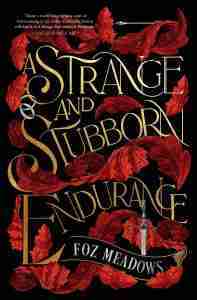 [GdM] Can you tell us about your newest novel, A Strange and Stubborn Endurance?
[GdM] Can you tell us about your newest novel, A Strange and Stubborn Endurance?
[FM] It’s a queer fantasy romance centered on the diplomatic marriage between two noblemen: Velasin vin Aaro, who’s from the homophobic nation of Ralia, and Caethari Aeduria, from the more liberal nation of Tithena. Vel, a gay man, is originally slated to marry Cae’s sister, but when he’s outed under ugly circumstances, the Tithenai envoy proposes that he marry Cae instead. Though Vel’s father is opposed to the new arrangement, as the alternative is to let the alliance fail, he allows it to go ahead, though not before effectively disowning his son. So Vel starts out the story in a very dark place, but his arc is ultimately one of healing – and at the same time, there’s political shenanigans afoot when he gets to Tithena, because not everyone is thrilled about the alliance.
[GdM] What was the genesis for the creation of A Strange and Stubborn Endurance?
[FM] I started writing the first draft in 2015, after I’d handed in my edits for An Accident of Stars, but before I was set to start work on A Tyranny of Queens, when I had a free moment and my brain, somewhat predictably, leapt at the chance to work on something new. I’d been enjoying writing queer romance in a fanfic context, so I wanted to try my hand at something original in a fantasy vein, and this was what came out. I didn’t plan the story: I just opened up a new document and Vel’s voice flowed onto the page, and suddenly I had this whole concept in my head that needed a home.
[GdM] How did you select the name of the novel?
[FM] The original working name for the book was The Killing Choice, in reference to a fictional queer fantasy novel I made up to include in a Supernatural fanfic. I wasn’t trying to write the story as described in the fic so much as riffing off the name I’d given it, and in the end, the title didn’t fit. So I went back into the text to look for inspiration, and settled on A Strange and Stubborn Endurance, which is what Vel is described as having at one point, and which feels much more representative of the story.
[GdM] How did Velasin vin Aaro’s character come about? What was his inception?
[FM] Honestly, he just showed up! I started writing and there he was, which is how it often feels when my creative hindbrain gets an idea but doesn’t deign to enlighten my conscious mind about all the underlying hows and whys. There’s just something there, and I know it’s mine, but it’s come from the black box part of my brain rather than the cockpit, if that makes sense, and when that happens, it’s generally best to just run with it.
[GdM] A Strange and Stubborn Endurance is a lot of things: a love story, a story about healing, friendship, cultural roles and the damage they can do, and recovery from trauma. How did you balance everything so well? Did the story organically grow as you wrote it?
[FM] I do sometimes plan out my novels, but this one was purely organic. I wrote the first half in about two months, sending day by day updates to my friend Liz Bourke, who was cheerleading me through it and continually asking for more – but then I had to stop and work on A Tyranny of Queens, for which I was contracted at the time, and after that, life got in the way for a while. I kept nibbling at it and tweaking the early sections over the next few years, but I didn’t actually come back and finish it until 2020 – at which point, the whole second half came out in about three months. So depending on how you measure it, the book either took five months or five years to write!
[GdM] What is next for you? What have you been working on?
[FM] The first book in my Manifold Worlds duology, An Accident of Stars, is getting rereleased in June, which is really exciting, and in addition to working on the sequel to A Strange and Stubborn Endurance, I’ve got a novella, Finding Echoes, coming out from Neon Hemlock in 2023. There’s also another couple of novels on the backburner, one of which I’m particularly eager to get to; working on it is going to be my reward for finishing the Endurance sequel. It’s a sort of reverse murder mystery in a setting where magic comes from being touched by gods, and I can’t wait to finish it!
Read A Strange and Stubborn EnduranceThe post An interview with Foz Meadows appeared first on Grimdark Magazine.
August 9, 2022
An Interview with Wesley Chu
Wesley Chu is an author who needs no introduction. He has been writing in science fiction and fantasy for over a decade and is the creator of the Tao series, Time Salvager, Io, The Eldest Curses, and now the Wuxia series, The War Arts Saga. Chu was kind enough to sit down with us and talk with us about his newest work, The Art of Prophecy, writing in existing fandoms, and so much more.
 GdM: In another
interview
, you said you enjoy adrenaline sports and extensive traveling. How are you getting your traveling and adrenaline fix lately?
GdM: In another
interview
, you said you enjoy adrenaline sports and extensive traveling. How are you getting your traveling and adrenaline fix lately?
Hah! That interview must have been before 2016, because I’ve since spawned two upgrades who are now six and three, so now the things that spark joy and excitement are the trivial things in life, like when my eldest successfully builds a complex Lego set (he just finished the Lego Optimus Prime! Boom!) or when my toddler forms a complex and nuanced sentence or sleeps through the night without pissing in his sheets.
I do want to start traveling again. Things have to be different though. I’m not the same person I was even just a few years ago. I’m in a different place with kids and, ugh, responsibilities. Adventuring can no longer be stuff like summiting a mountain or riding horseback through the steppes and retrace Temujin’s journey a thousand years ago. Now it’s more like let’s go glamping or at best pitch a tent on the truck overlanding in Yosemite or Joshua Tree.
GdM: Every author has different processes for writing a novel. Some start with sticky tabs, some draw on walls, and some just sit down and start writing. I am curious about your process. Can you tell me a bit about how you create a novel?
Can I tell you a bit about how I create a novel? This is a very existential question. I’m twelve books in and I’m honestly still not sure how it’s done.
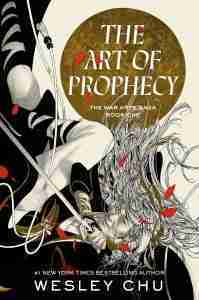 The beginning of new projection is often a bundle of random energy. It’s fresh and exciting and often inspired, but it’s also a drag because you’re wading into completely unknown territory. It’s a complete blank slate, which can be exciting but also terrifying. You don’t know the characters, you don’t know the tone, you may not even be sure what the setting is. You’re probably doubting the first sentence, maybe even the first word, but don’t worry because you are one hundred precent going to be writing and rewriting that opening paragraph twenty times anyway.
The beginning of new projection is often a bundle of random energy. It’s fresh and exciting and often inspired, but it’s also a drag because you’re wading into completely unknown territory. It’s a complete blank slate, which can be exciting but also terrifying. You don’t know the characters, you don’t know the tone, you may not even be sure what the setting is. You’re probably doubting the first sentence, maybe even the first word, but don’t worry because you are one hundred precent going to be writing and rewriting that opening paragraph twenty times anyway.
I’m normally a pretty methodical outliner, but I always try to pants the first three chapters of a new book and let my freak run wild. These three chapters are when I allow myself to just write uninhibited to see what heady and toxic mixture I can create with the characters and the world. It also allows the story to set its tone with me. By allowing the characters tell me who they are, it gives them the opportunity to inform me who they are, why they’re there, and justifies their place in this ecosystem.
I’m a firm believer that nothing exists in a vacuum, even character traits. If someone doesn’t like Airedale terriers, I’m going to automatically assume he’s a terrible person, but I also want to know why he does not like Airedale terriers. The circumstances surrounding that why he doesn’t like them may influence details about him.
GdM: What did it feel like to be a part of two long-running franchises? Was there added stress because of the die-hard fan base?
Having the opportunity to play in the sandbox of two iconic IPs was really cool experience. Their fanbases are deeply passionate, so there’s definitely an increased pressure to do right by them. One of the things that was an amazing resource was the deep well of history these properties already had. The Walking Dead had nearly two hundred comic issues, while Shadowhunters had twelve large tomes of history. There was so much lore to draw upon. At the same time, you had to be extra careful with continuity and create conflicting issues.
GdM: How did you approach writing in someone else’s world as you did with Cassandra Clare and Robert Kirkman? Did you research their style and adapt to it?
Skybound gave me full creative control over the process so I didn’t have to adapt to a particular style as long as I got the tone of TWD down. I researched by rereading all the issues of The Walking Dead, and then the story sort of told itself.
Shadowhunters was a different story. Cassie is a fantastic and creative writer, and she has created an amazing and deep interconnected world filled with these strong relationships between the characters. To write in that universe, you really had to study these characters and relationships pretty thoroughly.
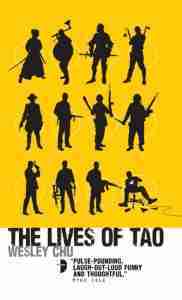 GdM: You have written in the science fiction, fantasy, and horror genres. Which genre do you feel most at home in?
GdM: You have written in the science fiction, fantasy, and horror genres. Which genre do you feel most at home in?
Middle grade, easily. I learned English reading fantasy books, but the source of my love for reading stemmed from all those amazing middle grade books I read as a kid. One of these days, I’m going to scratch that itch and try my hand at a cool middle grade book.
GdM: Clearly, not every story beat you think of makes it into a book. Can you tell us about a scene you had to mull over, and eventually, you had to “kill your darling?” Why did you ultimately decide to remove it?
I’ve killed a lot of darlings over the course of twelve books, but the first and most painful ‘kill the darling’ was with my debut novel, The Lives of Tao. I had submitted the novel through an one-month open submission period with Angry Robot. They had 996 entries that one month of which five received publishing contracts.
The editor at Angry Robot contacted me regarding their interest in Tao. They had a few notes they wanted me to make though, with one removing an entire plot line in the book, which effectively was like cutting and rewriting a third of the book. I loved that plot line, but I also understood the logic behind it, so I killed that darling and rewrote that plot as summary snippets at the beginning of every chapter. In the end, it was the right decision for the book, but it was definitely a tough one.
GdM: When you started out as an author, you did not know industry schmoozing was a thing until you went to your first Worldcon. What advice would you give to an aspiring author who has not yet published their first book and does not know what to say or how to schmooze?
Just be cool and respectful Everything else will fall in place. Careers may not be made at a con, but they can get wrecked before they even begin. Make friends, and understand that publishing isn’t a zero sum game. The only real competition anyone has is with themselves.
Bring lots of hand sanitizer, comfortable shoes, and have fun.
GdM: Can you tell us about your new novel, The Art of Prophecy?
I could spectacularly fail at describing the elevator pitch to you, because I can’t hand-sell my own books to save my life, but The Art of Prophecy is my most personal work. That’s saying something considering I modeled Roen Tan after myself. Quick segue, when my English Professor father read an early draft of Lives of Tao, he wrote in his notes, “Son, the book is good, except there’s an issue with your main character. He’s likable, but not very likable….is he modeled after you?”
The Art of Prophecy is not only my love letter to the wuxia genre, but also the final product of all of my passions throughout my life squeezed into one epic fantasy. It’s the story I deeply wanted to tell ever since I began writing, combining elements of wuxia and humor, honor and friendship, and high fantasy blended in an Asian setting but in an extremely specific tone that is wholly my most natural voice. This is the most ‘me’ book I’ll ever write.
GdM: Did you dream up the plot of Art of Prophecy?
It is true I dreamt the plots for my Tao and Time Salvager series. The idea of Tao came from my alarm clock when my I was training to hike Kilimanjaro. I was in one of those semi-conscious states when the 5AM alarm rang and I dreamt that it was a life coach in my head. With Time Salvager, I had a dream that I was a time traveler who arrived on the Titanic to steal the Hope Diamond. I spent several days on that ship befriending passengers knowing they were all doomed to die, and that I couldn’t do anything about it.
The Art of Prophecy, however, was a dream in the sense that it was a goal. I wanted to tell a wuxia story ever since I began writing. I broke into the industry with science fiction, but the framework around The Art of Prophecy had been simmering in my head since The Lives of Tao ‘s debut in 2013. At the time I had to stay on the science fiction track for a while and, honestly, I wasn’t ready to tackle this project. It wasn’t until 2019, after I had finished the two Shadowhunter and Walking Dead book that I felt like I was finally ready, experienced, and skilled enough to tell this story properly
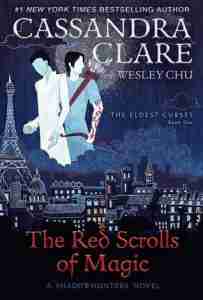 GdM: The cover of The Art of Prophecy is beautifully done, perfectly exemplifying the story’s mood and aesthetic. Were you a part of the art selection process for the cover design?
GdM: The cover of The Art of Prophecy is beautifully done, perfectly exemplifying the story’s mood and aesthetic. Were you a part of the art selection process for the cover design?
First of all, big props to Tran Nguyen for the front cover. It’s a beautiful work of art, and such a great ambassador for the book. I also want to credit Sunga Park, the artist who created the map for the series. Both of them just completely nailed it.
As for being part of the art selection, the team at Del Rey consulted with me every step of the way. I’m a fan of subject matter expertise, especially when it comes to artwork. I might have an idea of what I want, but what’s cool inside my head and how it ends up looking on paper are usually vastly different things. There are other factors to take into consideration like how the cover would look on a kindle, or whether the thumbnail of the image would translate well. But really, I also recognize that I often have questionable taste.
Fortunately, Cassie Gonzalez, the art director, and Tricia Narwani, my editor, were the ones who oversaw the process and gently guided and saved me from myself. They listened to my wild suggestions, and reigned me in when I got stupid. It was an extremely collaborative effort from beginning to end.
GdM: Tell me about Jian as a character. His stubborn nature must have been fun to write about, especially juxtaposed against Taishi.
Jian is probably the most honest character in The Art of Prophecy. Does he have vices? A mile of them. Is he arrogant and haughty while deeply insecure and stubborn? Sure. He’s probably like how any other teenager would be in his position. What makes Jian unique, however, is underneath his layers of bad nurture and entitlement, he’s got a considerate heart and a good instinct for justice. He’s a good kid. I like writing good kids.
Taishi is probably my favorite character of all time, even more than Roen Tan. I have a thing for writing crotchety old people. They’re so much fun and layered, and Taishi just owns the book with her sublime skill, sharp personality, and globs of muck and tragedy that she had acquired over her years as a war artist.
In many ways, Jian and Taishi are opposites, so it was a blast to put them in the same room and let them be themselves.
GdM: This story is written in three distinctive voices. Was it easy to switch between them? Or did you spend one day writing Jian, another as Taishi, and so on?
I hear character voices in my head, so it’s usually not too difficult to settle into their narrative and tone. They just start talking, and we just pick up where we left off. I’ve tried writing both ways. Sometimes, I just draft straight through chapter by chapter. Other times I will write an entire act one character at a time. Sometimes, for clarity and continuity’s sake, I’ll write in one character’s POV for several chapters. Other times, I’ll go straight chronological by chapter, which allows me to keep my tabs on the pacing. Both methods have their merits.
GdM: Now that Art of Prophecy is releasing, what is next on the docket?
First on the docket is handing in the sequel to The Art of Prophecy. That should be done by the time you read this (hopefully!).
Next on the docket after finishing a book is usually a couple of months off. I always crunch near the completion of the book, so I’d like to pay my family back for that lost time. After that, I usually need to alternate IPs as a palate cleanser, so I may finally try that middle-grade book that keeps kicking around my head. I also need to finish the Io books, so we’ll see. It should be a fun few years!
Read The Art of Prophecy
The post An Interview with Wesley Chu appeared first on Grimdark Magazine.
August 8, 2022
REVIEW: Slaying the Dragon: A Secret History of Dungeons and Dragons
Dungeons and Dragons and its parent company in the Eighties, TSR, had a fascinating story that has mostly been shared around by gamers at cons as well as word of mouth for decades. This isn’t the story of the Satanic Panic that both vilified gamers and drove sales through the roof. No, Slaying the Dragon: A Secret History of Dungeons and Dragons is a story of the internal politicking that led to the rise of TSR as a corporate entity under Gary Gygax, his loss of the company to Lorraine Williams, and how it was ultimately acquired by Wizards of the Coast before becoming yet another corporate culture.
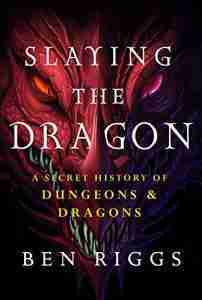 Generally, popular wisdom holds Gary Gygax as blameless and portrays Lorraine Williams as the villain who stole his company but Ben Riggs has a very different sort of take on things. Indeed, his portrayal of Lorraine Williams makes her every bit as endearingly quirky as the rest of TSR’s creatives. Gary Gygax was a creative genius but a poor businessman according Slaying the Dragon: A Secret History of Dungeons and Dragons, spending boatloads of money on bizarre projects like trying to take a shipwreck from the bottom of a lake as well as a hard-R Dungeons and Dragons movie when they were presently marketing it to kids.
Generally, popular wisdom holds Gary Gygax as blameless and portrays Lorraine Williams as the villain who stole his company but Ben Riggs has a very different sort of take on things. Indeed, his portrayal of Lorraine Williams makes her every bit as endearingly quirky as the rest of TSR’s creatives. Gary Gygax was a creative genius but a poor businessman according Slaying the Dragon: A Secret History of Dungeons and Dragons, spending boatloads of money on bizarre projects like trying to take a shipwreck from the bottom of a lake as well as a hard-R Dungeons and Dragons movie when they were presently marketing it to kids.
Lorraine Williams was an excellent businesswoman, by contrast, but not as interested in the creative side of things and attempted to keep her distance in the company from employees. Which was bizarre given its tiny size and enthusiastic love of the material. She was also obsessed with the Buck Rogers IP and erroneously believed it would be a massive success. Later, she would attempt to move out of the tabletop roleplaying game business into paperback publishing because they were selling far more of those than they were of games. This, as you could imagine, didn’t go over well with all of the obsessive gamers within.
The book is full of fascinating details and, to be frank, dirt on the history of TSR as well as its parents. There’s some genuinely scandalous revelations about the people involved as well as the treatment of employees. Margaret Weis, mother of Dragonlance, made only $30,000 a year while being the best-selling author who was actually keeping the company afloat. Gary Gygax was cut out of a massive portion of his profits that he was entitled to. Random House, of all people, was cheated by TSR when the latter tried to give them a massive amount of product no one was buying (Dragonstrike) in order to get a huge check.
The depiction of TSR in the book is a company that was populated by rabid fans working primarily for their love of the product that didn’t really adjust too well to being an actual business. A lot of bizarre and insane mistakes were made but no one is a true villain. Many people were underpaid (Ed Greenwood was given about $2,000 dollars for the Forgotten Realms’ rights and even then only a courtesy) but everyone seemed to love what they were doing until they suddenly weren’t doing it because of mismanagement.
Really, if anyone comes off as a hero of this, it is the most unexpected one in Peter Adkinson. He not only bought TSR despite the company was five million dollars in debt but paid off all of their individual artists, including Gygax. He also was willing to buy the company despite the fact Lorraine Williams had a personal detestation of him that seems to have originated in her belief that Wizards of the Coast was their biggest rival despite them not making tabletop RPGs.
The writing is crisp and humorous, often highlighting the absurdities of the situation without making much in the way of direct judgement. It is an unflattering but not condemnatory depiction of TSR and would make a great basis for a Mad Men or The Pirates of Silicon Valley-esque drama. I strongly recommend this as a easy-to-read introduction into the history of Dungeons and Dragons.
Read Slaying the Dragon: A Secret History of Dungeons and DragonsThe post REVIEW: Slaying the Dragon: A Secret History of Dungeons and Dragons appeared first on Grimdark Magazine.
August 7, 2022
REVIEW: A Feast for Crows by George R.R. Martin
A Feast for Crows is the fourth and most polarizing volume in George R.R. Martin’s epic grimdark series, A Song of Ice and Fire, which began with A Game of Thrones and continued with the excellent A Clash of Kings and A Storm of Swords. Although A Feast for Crows falls short of these three previous volumes, there is still a lot to love here, particularly in the detailed psychological portraits painted of Cersei and Jaime Lannister.
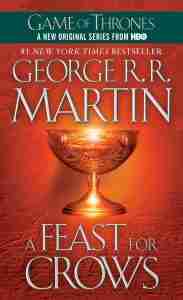 On the negative side, several of the main characters from the first three books are simply not present in A Feast for Crows. Daenerys Targaryen, Jon Snow, and Tyrion Lannister are all sorely missing from this fourth volume. As the most compellingly drawn character in the series, Tyrion’s absence is particularly regrettable.
On the negative side, several of the main characters from the first three books are simply not present in A Feast for Crows. Daenerys Targaryen, Jon Snow, and Tyrion Lannister are all sorely missing from this fourth volume. As the most compellingly drawn character in the series, Tyrion’s absence is particularly regrettable.
Instead, A Feast for Crows grants point-of-view status to a cadre of side characters who aren’t even provided names in their chapter headings. These chapters are given titles such as “The Prophet,” “The Captain of the Guard,” and “The Soiled Knight.” With such a large cast of characters already in A Song of Ice and Fire, it is difficult to justify the page space devoted to these new additions. It’s also frustrating for readers who just want to find out what happens to the main dramatis personae of the series. Unfortunately, the chapters devoted to these side characters mostly serve to slow down the main plot and interrupt the flow of the story. Despite its slow start, A Feast for Crows picks up the pace later in the book and has an especially strong finish.
Cersei Lannister steals the show as a first-time point-of-view character in A Feast for Crows. George R.R. Martin thoroughly immerses us in Cersei’s twisted mind as she descends deeper into jealousy, paranoia, and hysteria. Martin’s analysis of Cersei’s psychology is superb and, frankly, worth the entire book.
The relationship between Cersei and her brother Jaime is damaged beyond repair in A Feast for Crows. Jaime is obsessed with Cersei’s many infidelities, unable to force the list of her illicit lovers out of his mind. Ever the loyal knight, Jaime is also trying to find a new purpose for himself after losing his sword-wielding hand in the previous book. The phantom sensations that Jaime feels from his missing hand brought me chills.
Brienne of Tarth is another favorite character in A Feast for Crows. After spending A Storm of Swords guiding Jaime back to the Lannisters, Brienne now sets off in search of the missing Sansa Stark. The highlight of Brienne’s story occurs when she meets Lady Stoneheart, the zombified Catelyn Stark who is hellbent on revenge against those who betrayed her at the Red Wedding massacre in the previous book. I’m surprised that Lady Stoneheart was left out of the HBO series, as she is such a haunting and menacing presence in A Feast for Crows.
The Stark sisters, Sansa and Arya, are given three chapters each. Littlefinger has rescued Sansa from the Lannisters and rechristened her as Alayne Stone, pretending to be his illegitimate daughter. Littlefinger is captivated by how much Sansa looks like her mother, Catelyn, for whom he has a longstanding infatuation. Littlefinger’s interactions with Sansa alternate between creepiness and education in the fine art of political manipulation.
Meanwhile, Arya continues her aimless wandering, this time sailing to the foreign city of Braavos, where she adopts yet another pseudonym. Arya’s storyline ends on a cliffhanger, so I’m excited to see what happens next.
Despite its flaws, A Feast for Crows is still a great book. Although it falls short of its predecessors, the chapters devoted to Cersei, Jaime, and Brienne are all outstanding, and it also carries the story forward for Sansa and Arya. If readers can forgive the unnecessary diversions from the side characters, there is still much to love here.
Read A Feast for Crows by George R.R. MartinThe post REVIEW: A Feast for Crows by George R.R. Martin appeared first on Grimdark Magazine.
August 6, 2022
REVIEW: Dragons of Deceit by Margaret Weis and Tracy Hickman
Many years ago, I stumbled across a book called Dragons of Autum Twilight, book one in the Dragonlance Chronicles. There was a dragon on the front (I’m a sucker for dragons), and characters who looked right out of the cover at the reader, inviting them on an adventure. I opened the book and immediately fell in love with the world of Krynn, the characters, and the writing.
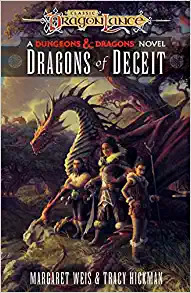 Fast forward more years than I’ll admit. I’ve read those books more times than I can count. I have devoured every new novel that takes place in Krynn, seen visions of the world painted by many authors. Each new novel adds to the lore and shows a new perspective. I like the majority of them, but the books by Margaret Weis and Tracy Hickman, the creators of the world of Krynn, are special. I was ecstatic to hear the news that they were returning to the world they birthed.
Fast forward more years than I’ll admit. I’ve read those books more times than I can count. I have devoured every new novel that takes place in Krynn, seen visions of the world painted by many authors. Each new novel adds to the lore and shows a new perspective. I like the majority of them, but the books by Margaret Weis and Tracy Hickman, the creators of the world of Krynn, are special. I was ecstatic to hear the news that they were returning to the world they birthed.
Dragons of Deceit is the first of the new trilogy, Dragonlance Destinies. It’s been years since the last Dragonlance written by the masters was released, but they didn’t miss a beat. I wondered before reading it if this book would appeal more to new readers or to readers returning and hoping to see the characters they love.
The thing that I’ve always loved about the Dragonlance series is that it feels as though the world continues long after you’ve read the last sentence and closed the book. Reading Dragons of Deceit was like catching up with friends I haven’t seen in a while. They’ve had new adventures, met new people. The world has kept going, but it happily welcomed me back.
The book follows Destina, the daughter of a Solamnic knight. She loves her father, the knighthood, and all it stands for, until the oath all knights take (“My honor is my life”) causes her to lose him. Her life crumbles around her and she hatches a hare-brained scheme: travel back in time and save her dad. Of course, in order to do that, she’ll have to visit a certain well-traveled kender to acquire the Device of Time Journeying. That’s when things start to go sideways, as they always do when kender are involved.
Sometimes a long-running series finds itself in a bind. Do you continue with a storyline that new readers might be confused by, but rewards longtime readers? Or do you tell a story that has an entry point for new readers, risking alienating returning readers who want something new (I’m thinking of the multitude of Spiderman origin stories here)?
Weis and Hickman cleverly sidestepped this issue and wove a tale that will appeal to new readers and longtime fans alike. There is a mix of old and new characters, and a story arc that leans on already-established lore while still managing to be an entry point. All the important history is given throughout the book, while still somehow avoiding the dreaded info dump. New readers will be able to follow the plot without confusion, although there are things that returning readers will appreciate more.
Destina is an intriguing character, one at odds with herself. She is loyal and looks up to her father but is rather snotty toward her mom. She puts a huge burden of responsibility on herself, and it weighs her down until she has nothing left. I can’t say that I liked her in the usual sense; she was distinctly unlikable at times, which sometimes makes for a more complex story. I couldn’t fault her motivation. Wouldn’t we all do pretty much anything to help a loved one if we had the chance?
Tas was fantastic, of course. I really love that doorknob of a kender! He’s the perfect blend of innocence and unknowing wisdom. He provided laughs aplenty and a few moments that caused me to choke up a little. There’s a scene involving a helm topped with the hair from the mane of a griffin (if you know, you know) that caused my stone heart to melt.
The story was fast-paced and exciting, the sort of adventure I love reading about. It ended with a bang and left me wishing I had a Device of Time Journeying of my own, so that I could travel forward and read book two. Unsurprisingly, Dragons of Deceit was incredible. When I finished the last word, I was stymied: do I immediately reread it, or do I go back to the Chronicles– the original three that started it all- and reread every brilliant Dragonlance book written by Weis and Hickman? Deciding is nearly impossible, and that is the best kind of problem to have.
Read Dragons of Deceit by Margaret Weis and Tracy HickmanThe post REVIEW: Dragons of Deceit by Margaret Weis and Tracy Hickman appeared first on Grimdark Magazine.
REVIEW: Strange Cargo by Patrick Samphire
Mennik (Nik) is back and in even bigger trouble than usual, in the third installment in the Mennik Thorn series. Strange Cargo was one of my most anticipated books of the year and it did not disappoint. It was awesome, unsurprisingly.
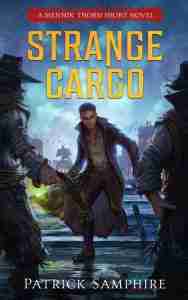 I am a sucker for books featuring down-on-their luck rapscallions who can’t seem to stay out of danger. Whether it’s a smart mouth at the wrong time, or a penchant for chasing trouble, these kinds of characters keep me smiling and guessing. Mennik Thorn is high on my list of favorite trouble-finders and each book in the series makes me like him more.
I am a sucker for books featuring down-on-their luck rapscallions who can’t seem to stay out of danger. Whether it’s a smart mouth at the wrong time, or a penchant for chasing trouble, these kinds of characters keep me smiling and guessing. Mennik Thorn is high on my list of favorite trouble-finders and each book in the series makes me like him more.
After the events of Nectar for the God, book two in the series, Mennik is on the outs with his best (and some would argue, only) friend. He’s also unfortunately on the outs with a group of smugglers. Seeing as they’d happily see him dead, they choose the next best thing and pressure Mennik into a job protecting an item they plan to smuggle into Agatos. Of course, if he ends up dead in the process, that’s just a perk for them, right?
Not only does this “job” not pay, but it’s also incredibly dangerous. Once Mennik learns what it is he’s helping smuggle in, things go from sideways to dangerous. I won’t ruin the surprise, but it’s a doozy. The stakes keep going up from book to book, keeping me interested and wondering what fresh hell Mennik will find himself in next.
I love that Mennik always has another side problem that he’s trying to solve while the main story arc takes up most of the attention. In this instance, Mennik’s less-than-enthusiastic client is none other than the cranky owner of the crap bar Mennik frequents. Their passive-aggressive conversations entertained me to no end.
Mennik is a brilliant character, a study in contradictions. He tries to do the right thing, but he rarely knows what the “right thing” is. He’s smart-mouthed and mocks pretty much everyone but he is equally mocking of himself. He would probably have a longer life expectancy if he didn’t feel the urge to help people (even when they serve him subpar alcohol), but he can’t seem to stop helping anyway. Oh, and he might as well write Killed by Curiosity on his headstone now and get it over with.
Of course, his character does not exist in stasis. He has grown and changed since book one (Shadow of a Dead God), although he remains delightfully disaster prone. Strange Cargo doesn’t highlight that character growth quite as much because it is shorter (more of a novella than a full-fledged novel). In some ways it shouted “side quest” but it still managed to pack in revelations and world development aplenty.
As always, the writing is phenomenal. Everything is brilliantly described, painting vivid pictures of both Agatos and its inhabitants. The dialogue is witty, and things move at a quick pace. Strange Cargo showcased all the things that I love about the series and made me hungry for more. Book four in the Mennik Thorn series can’t come soon enough!
READ CARGO BY PATRICK SAMPHIREThe post REVIEW: Strange Cargo by Patrick Samphire appeared first on Grimdark Magazine.
August 5, 2022
REVIEW: Fire and Blood by George R.R Martin
George R.R. Martin released A Dance with Dragons in 2011 and we’ve been waiting eleven years for the sequel, The Winds of Winter. However, that doesn’t mean that he hasn’t been active during this time. He has been laying the groundwork for multiple new television series, wrote part of The World of Ice and Fire, and hinted at continuing his Dunk and Egg series that I quite enjoy. However, I think the thing he accomplished most in that time is Fire and Blood.
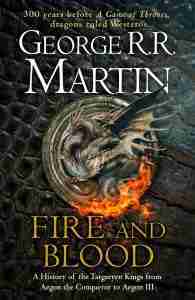 I should note I don’t hold the long wait between books against George R.R. Martin before I continue. I’m one of the people who believes the issue is less not working on it than the fact the story has grown like tree branches from the main trunk with no end in sight. People want the story of Daenerys, Jon, Arya, and Tyrion but he’s become caught up in the tales of Young Griff as well as Penny the Jester. Mind you, my suggestion would be to do side-series andhave a hundred books like Dragonlance but I’m terrible that way.
I should note I don’t hold the long wait between books against George R.R. Martin before I continue. I’m one of the people who believes the issue is less not working on it than the fact the story has grown like tree branches from the main trunk with no end in sight. People want the story of Daenerys, Jon, Arya, and Tyrion but he’s become caught up in the tales of Young Griff as well as Penny the Jester. Mind you, my suggestion would be to do side-series andhave a hundred books like Dragonlance but I’m terrible that way.
Fire and Blood is a crypto history of Westeros, specifically the Rise and Fall of the Targaryen Dynasty starting with Aegon the Conqueror then moving through each successive generation until reaching Aerys the Mad. This is an expansion of the history found in The World of Ice and Fire as well as the Song of Fire and Ice books themselves. This might seem to be boring, but George R.R. Martin maintains his deft touch creating fascinating relationships and bringing characters to life that could each be the base of their own series of books or shows. George remains perfectly capable of creating vivid personalities that leap from the page even when they don’t have any dialogue or appearance on page save descriptions about them.
My favorite of the Targaryen dynasties is the Dance of the Dragons between Rhaenyra Targaryen versus Aegon the Second and his mother, Alicent Hightower. This is going to be the basis of the House of the Dragon show so I’m not going to get to into the details, but it is a fascinating story of primogeniture, backstabbing, love, and dragons. The fact it’s about a Targaryen Civil War that has dragonriders on both sides means that I am very excited to see it onscreen.
This is primarily a work for those who absolutely love Westeros history and world-building, but it is never boring despite being a history text. George is smart enough to keep all the salacious and twisted details about the Targaryens intact throughout the text while real-life history often downplays these elements. Was Aegon I’s eldest child really his or a singer’s? Was Maegor the Cruel resurrected as a zombie? What really was going on at Summerhall?
George R.R. Martin is the master of the “Mystery Box” form of storytelling and leaves all manner of breadcrumbs as well as clues to lead his readers on. However, unlike the majority of said users of this trope ala Chris Carter and JJ Abrams, it’s clear he does have answers to the mysteries he invokes. There’s all sorts of riddles for the ages spread throughout the book but you aren’t left unsatisfied either because the book often offers their own suggestions as to what might have happened.
The art of the book is black and white compared to the vibrant colors of The World of Fire and Ice. Still, the art is fantastic, and helps add to the book’s appeal. Still, I must admit that I’m a huge fan of the character art in other Westeros-related media and feel like they could have inserted more of that here for the benefit of readers. It’s not like George R.R. Martin or the publishers can’t afford it.
In conclusion, Fire and Blood is a fantastic companion piece to both A Song of Ice and Fire as well as the Game of Thrones media empire. If you’re not fantastically into the world-building and history of the setting, though, you will probably be disappointed. This is not a novel but more a very well-done pseudo-history of events. A summary of the good parts, really, that is done in an entertaining and well-formatted style. It also spoils the hell out of a lot of potential projects that may someday be shows.
4.5/5
Read Fire and Blood by George R.R MartinThe post REVIEW: Fire and Blood by George R.R Martin appeared first on Grimdark Magazine.
August 4, 2022
REVIEW: The Memory Librarian by Janelle Monáe
Janelle Monáe is widely acclaimed as a singer/songwriter, film star, fashion icon, and social activist. Her list of awards has its own Wikipedia page, with 137 nominations and 48 wins at the time of writing this review. With the release of her debut book, The Memory Librarian, Monáe can now add published author to her impressive list of accomplishments. Is there anything Janelle Monáe can’t do?
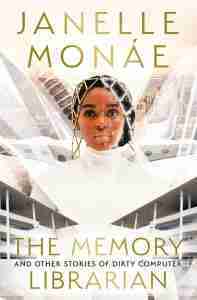 Monáe is a lifelong science fiction enthusiast, even stylizing an android alter-ego for the recording of her first album, The ArchAndroid. Her most recent album, Dirty Computer, is a genre-bending Afrofuturist masterpiece rooted in hip hop but with varied influences ranging across pop, rock, funk, and soul.
Monáe is a lifelong science fiction enthusiast, even stylizing an android alter-ego for the recording of her first album, The ArchAndroid. Her most recent album, Dirty Computer, is a genre-bending Afrofuturist masterpiece rooted in hip hop but with varied influences ranging across pop, rock, funk, and soul.
Dirty Computer is a concept album that imagines a dystopian future where technology is used to wipe the memories of non-conformists living under an Orwellian techno-authoritarian regime. The album is a perfectly crafted sonic masterpiece, brimming with emotion and delivering an impassioned message about social justice.
The world of Dirty Computer comes visually to life in Monáe’s 44-minute companion film, or “emotion picture,” which is freely accessible on YouTube. The emotion picture incorporates Monáe’s full set of music videos for the album, interwoven with narrative snippets that provide context for the story and show how the individual songs fit together within her overarching theme. With the publication of The Memory Librarian, the totality of Monáe’s vision has come to life, spanning across the auditory, visual, and now the written word.
The Memory Librarian contains five stories set in the world of Dirty Computer. Monáe has recruited five well-accomplished collaborators for her literary debut, one for each story. The first two stories are novella-length and co-authored by Alaya Dawn Johnson and Danny Lore. The remaining three short stories are co-authored with Eve L. Ewing, Yohanca Delgado, and Sheree Renée Thomas. Monáe’s collaborators bring remarkable credentials and a long list of literary awards and achievements to this project.
Before opening the first pages of The Memory Librarian, I was honestly a bit concerned that having a different collaborator for each story might lead to an inconsistent tone or style across the book. Fortunately, my concern was unfounded, as Monáe’s voice shines vibrantly across the pages of all five stories with remarkable fluidity.
While many sci-fi novels devote excessive time explaining their world and related technologies, Janelle Monáe takes the opposite approach, focusing on the people who inhabit this dystopian world governed by the neofascist, technocratic New Dawn regime. Individuals who fail to meet New Dawn’s strict rules of conformity are labeled as “dirty computers,” having bugs that must be eliminated through violent attacks, imprisonment, and memory erasure.
The stories in The Memory Librarian address issues of racism, feminism, homophobia, and more, as New Dawn specifically targets members of the queer Black community. Readers will be profoundly moved by the experiences of these characters who face such violent intolerance just for being themselves and living their own authentic lives. I found Monáe’s treatment of gender identity and transphobia to be especially powerful. Although the discussions of morality could come across as heavy-handed at times, I believe this is the right approach for addressing such critical issues in basic human rights.
Janelle Monáe is one of the finest lyricists in modern music. Although The Memory Librarian doesn’t quite rise to those same poetic levels, it remains beautifully written and eminently readable throughout. Long-time fans of Janelle Monáe (lovingly dubbed “fandroids”) will appreciate the subtle references to her discography scattered throughout the book.
While The Memory Librarian can stand on its own as a powerful work of literature, the impact of the book is greatly enhanced when read in the context of Dirty Computer and the accompanying emotion picture. Janelle Monáe has completed an extraordinary trifecta of artistic expression across three forms of media. As a combined artistic work, Janelle Monáe earns an enthusiastic 5/5 from this appreciative fandroid.
Read The Memory Librarian by Janelle MonáeThe post REVIEW: The Memory Librarian by Janelle Monáe appeared first on Grimdark Magazine.
August 3, 2022
Generation Gangster
The War for the Rose Throne is complete. I need a lie down.
It’s quite a strange feeling, in all honesty. Although Priest of Crowns will be my seventh published novel, this is my first completed series – the trilogy that ended up being a quartet thanks to my narrative runaway express train and the endless patience of my wonderful editor Jo Fletcher. The Burned Man series got killed by the publisher three fifths of the way through so it never ended properly and I’ll always be sad about that, but this time it is done. It’s the story I wanted to tell, and I finally got to do that. Second time lucky I guess.
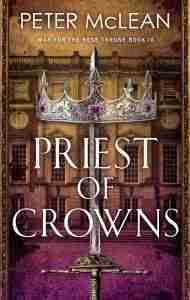 And now I’ve told it, and it’s done, and that’s great feeling. In a way it is, anyway. This is Tomas Piety’s story told, and I guess it’s time to say goodbye to him and Bloody Anne and Fat Luka and all the others, and Our Lady only knows I’ll miss them. But as a great man once said, there are other worlds than these.
And now I’ve told it, and it’s done, and that’s great feeling. In a way it is, anyway. This is Tomas Piety’s story told, and I guess it’s time to say goodbye to him and Bloody Anne and Fat Luka and all the others, and Our Lady only knows I’ll miss them. But as a great man once said, there are other worlds than these.
The War for the Rose Throne has been my love letter to both the Dark Fantasy genre and to gangster family sagas like The Godfather and Goodfellas. I grew up on that stuff, and Mickey Spillane and David Gemmell and lots of other things I probably shouldn’t have been reading at that age. Hey, it was the 80s. No one was looking, right?
I think that was both the blessing and the curse of being a Gen X kid, so neatly summed up in one sentence: No one was looking. It gave us freedom, and it gave us scars.
That’s something I’ve come to realise was an underlying theme of these books all along, even if I didn’t consciously know that was what I was doing when I was writing them. You have to remember with these books that you’re reading Tomas Piety’s memoirs written long after the fact, and he is neither an educated man not a particularly reliable narrator, but certain things keep coming through.
Some people have noted that the prose can be repetitive at times and yes, it can, and that’s completely deliberate. Homer is repetitive, for heaven’s sake. How many times do we hear “the wily Odysseus”? Oral storytelling works like that, it just does. Anna Smith Spark does it too in her superlative Empires of Dust trilogy, and again she does it completely on purpose.
Think about it: Tomas’ only exposure to narrative expression has been an occasional visit to the theatre, where oral storytelling revolves around key phrases oft repeated, and so he tells his own story in the same way. That’s not the point though. I was doing that on purpose. This is about the bit I wasn’t doing on purpose.
“Look a me Ma, I’m the governor of Ellinburg.”
“Look at me Ma, I’m a knight.”
It’s just the sort of shit kids say when they’re playing pretend, right?
Look at me, Ma.
No, no it isn’t. I thought it was too when I was writing it, but it’s not. It’s a cry for help, for acknowledgement, for a place in the world. All the things Tomas never had. And I think he knew that all along, even if I perhaps didn’t when I was writing it. Not until I got to the last book, anyway, and all the pieces fell into place in my head.
Tomas is the epitome of the 70s / 80s “latchkey kid”. He had no parents really in the picture when he was young, and the only one who was there at all was a monster. He barely remembers his mother and he loathed his abusive father to the point that he murdered him when he was only twelve himself, to save his little brother from their father’s predations. But he reveres the memory of his mother, or at least the idea of her that he’s built up for himself in his head as a kind of defence mechanism. It’s all fake, of course. She died when he was only about five or six and he has no idea what she was really like, but he’s built his whole existence around earning the approval of the mother he thinks he had.
The mother he wanted to have, wished he’d had. So yeah.
I’ve said before that I’d written the last chapter of Priest of Crowns before I’d even finished Priest of Bones, including those final lines, and I had, but I don’t think I knew then exactly why I had.
I do now.
Anyway, maybe that was some weird kind of catharsis for me, or maybe I’m just telling a story. Maybe you’ll enjoy it, maybe I’ll make you cry.
Maybe both. That’s the joy of storytelling, isn’t it?
You take away the story you want to find.
Read Priest of CrownsThe post Generation Gangster appeared first on Grimdark Magazine.



